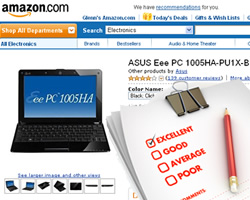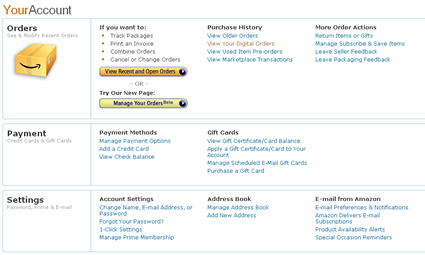 When I work on e-Commerce optimization projects, I often take clients through several examples of what I consider to be e-Commerce excellence. While I go through this process, it usually doesn’t take long before I mention Amazon.com. Amazon consistently exceeds my expectations with selection, ease of use, access, security, and customer service. I’ve written previously about how strong Amazon is, including a post last year about mobile e-Commerce. I explained how Amazon blurred the line between making a purchase via your browser and your mobile device. It’s just another example of how Amazon goes above and beyond to ensure customers can access, browse and purchase across devices. So, after placing yet another order with Amazon late last week, I started to think about the reasons I visit Amazon over other e-Commerce websites. I also started to think about how those reasons apply to other websites (and possibly yours).
When I work on e-Commerce optimization projects, I often take clients through several examples of what I consider to be e-Commerce excellence. While I go through this process, it usually doesn’t take long before I mention Amazon.com. Amazon consistently exceeds my expectations with selection, ease of use, access, security, and customer service. I’ve written previously about how strong Amazon is, including a post last year about mobile e-Commerce. I explained how Amazon blurred the line between making a purchase via your browser and your mobile device. It’s just another example of how Amazon goes above and beyond to ensure customers can access, browse and purchase across devices. So, after placing yet another order with Amazon late last week, I started to think about the reasons I visit Amazon over other e-Commerce websites. I also started to think about how those reasons apply to other websites (and possibly yours).
Here’s a quick, yet important question you should ask yourself (and yes, I understand that every website can’t be like Amazon):
In your industry, are you the knee-jerk reaction for buying online?
It’s such a basic question, but can mean the difference between thousands or millions of dollars in revenue… Do customers think of your business first when they need to buy something? For me, Amazon is often the first website that comes to mind, and there are several reasons for this. As I was writing down the core reasons that I buy at Amazon so much versus other websites, I noticed that I was inadvertently listing the pillars of e-Commerce excellence. More on this shortly.
An Impromptu Friday Afternoon e-Commerce Purchase
Last Friday I needed to buy something quickly. I was in between meetings and only had a few minutes. Literally the first business that came to mind was Amazon.com. I could have purchased the item at a number of websites, but Amazon was my knee-jerk reaction. I also could have stopped on my way home, but Friday evening and New Jersey traffic don’t mix well, to say the least. So I opened up a new tab in Firefox, accessed the website, searched for the product, visited the product detail page and added it to my cart. I then quickly checked out and completed the purchase in less than 90 seconds. From an e-Commerce perspective, that’s simply outstanding. I closed the tab, received a confirmation email and was back on another conference call. Then, less than two hours later, I received a shipment notification.
{Update: I just received my order on Monday afternoon using standard shipping. Simply outstanding.}
OK, remember the pillars I mentioned above? Let’s take a look at each pillar of e-Commerce excellence and how Amazon has successfully achieved a first-in-mind advantage.
The Pillars of e-Commerce Excellence:
1. Accessibility and Simplicity
Amazon.com makes it easy to access their website across devices. Amazon also makes it simple to find products, read reviews, view product information, check technical specs, find out what other people have purchased, etc. On Amazon, I’m able to visit the site, search for what I need quickly, and view all of the necessary information in order to make a purchase decision. There are no hoops to jump through, and I don’t necessarily need to be in front of my computer to buy something.
2. Speed and Organization
Amazon.com loads fast, provides an easy to navigate organization of categories, which is almost unnecessary based on how good their on-site search is. Amazon’s search functionality enables you to easily search within their main categories. It’s fast and provides outstanding search results. Product detail pages on Amazon provide a thorough breakdown of valuable information. Note, I said thorough and not elegant and I’ll explain more about that soon. As I explained earlier in the post, I can make a purchase in less than 90 seconds. I can always quickly find what I need, add it to my cart and then check out in a flash. My order is always quick to arrive, but that’s included in another pillar below. A quick recap of pillar #2: Fast, fast, fast, and fast. :)
3. Trust and Security
Security is a big concern in e-Commerce, and it will only become a bigger concern as time goes on and technology progresses. For e-Commerce managers, a lack of security and trust can become a horrible barrier to conversion. However, if you can have prospective customers feel confident that their security is first and foremost, then you can reap great rewards revenue-wise. I always feel 100% confident when I’m buying at Amazon. If you put yourself in the mind of a consumer (and not a marketer), you can quickly understand how people browse through sites and what might be a problem conversion-wise. Some questions pop up like “who owns this site?”, “how long have they been around?”, “where are they located?”, “what happens if I need to return something?”, “how secure is this website?” …so on and so forth. The more you build trust, the easier it is for a person to click “Buy now” or “Proceed to Checkout”. Personally, I don’t even think about security when I’m on Amazon. That’s how much trust they have built up with me. I’ll cover my points system later in the post.
4. Communication and Customer Service
I’m not sure there is anything more frustrating than buying something and then having to jump through hoops to track the order, view order information, contact customer service, or return merchandise. It’s definitely a problem with buying online, and rightfully so based on some e-Commerce operations. Amazon makes it easy for customers to find any information they need, from invoices to tracking information to returns. Simply clicking on Your Account brings you to self service screen that enables you to handle a wide range of customer service tasks. Amazon knew this was important, and knew it could also save them money (a lot of money). Amazon empowers customers to handle various account related tasks by themselves. By far, it’s the fastest and most cost-effective way to handle this. Again, they make it easy for me to want to buy from them…
The Self Service Account Screen on Amazon.com:

The Glenn Gabe Virtual Points System
You may not think about it this way, but you probably have a points system too. Every time I deal with a company and have a good experience, they earn virtual points in my mind. During an average experience, no points are awarded. During a negative experience, several points are deducted, and it depends on how serious the problem was to know how many points should be deducted. Over the years, Amazon has earned a mountain of virtual points. In fact, it has earned so many G-Squared points, that it has earned rollover points. That’s right, it means Amazon could actually screw up a few times, and I would probably still go back. And unlike my friends at AT&T, my G-Squared rollover points don’t expire. ;-)
A Quick Tangent About Website Design and Conversion:
For those of you that obsess about ultra-slick web design, head over to Amazon.com now. Amazon is pretty well known for their continual e-Commerce optimization. From a design standpoint, their pages are relatively plain, they are text-heavy, and it seems like images are thrown around the page. But let me tell you, they convert! They provide all of the necessary information in order to convert browsers into buyers. The pages load fast and have valuable segments of information that push you closer and closer to buying. It proves you don’t need crazy functionality or a beautiful design to be a leader in e-Commerce. My advice is to optimize for conversion, and not for awards. :)
Strive for e-Commerce Excellence
So yes, Amazon is the proverbial knee-jerk reaction when I need to buy something online. And I’m sure it won’t surprise you to know that Amazon is probably the knee-jerk reaction for thousands of other people too. But they deserve it and have quite a few G-Squared rollover points to play with.
Here are some quick takeaways:
1. In your industry, is your business the knee-jerk reaction for buying online? If not, which company is? What can you do to get closer?
2. How does your business fare when it comes to the four pillars of e-Commerce excellence I listed above? Can you improve any of the areas quickly while developing a plan to tackle the others?
3. Are your customers writing blog posts about your business like the one I just wrote about Amazon.com? How can you get them to become company evangelists?
Now that you know how I feel about Amazon, I’d like to hear about your favorite companies or e-Commerce websites? Why are they your knee-jerk reaction for buying online?
GG
